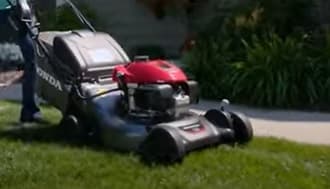As an Amazon Associate, this site earns commissions from qualifying purchases. For more information click here.
Does your lawn mower refuse to start after winter storage? You are not alone as this is a fairly common problem. And I know how frustrating it can be if your lawn needs maintenance now. I have good news for you though, as the solutions for this are not as difficult as you might think.
If your lawn mower refuses to start after winter, it is probably due to old fuel left in the tank. Another possible reason is a dirty carburetor, a worn out spark plug, or if you are using a cordless lawn mower, a dead battery.
Old Fuel
If you are going to store a lawn mower for the winter, empty the fuel tank. Or if you want to leave fuel in, put fuel stabilizer in it as a safety measure. Because if you don’t, the gas is going to turn into a sticky substance and spread all over the engine.
Gas turns into sticky residue if left sitting for 30 days or longer. This can happen any time of the year, but it is most vulnerable during winter. The low temperature is going to make the fuel unusable by springtime.
Solution. If the fuel has turned gummy, empty the tank, clean it and pour fresh fuel. You cannot make the old fuel usable. Just replace it and try starting the lawn mower again. The best way to prevent this is to empty the fuel tank or add fuel stabilizer.
Dirty Carburetor
If you let gas sit for months, it is going to evaporate and leave behind a gummy substance. It will spread throughout the system including the carburetor. If the residue is not removed, the engine is not going to start. Even if it does, it will shut down eventually.
Solution. To clean a carburetor, a cleaning kit like the Desin Carb Cleaning Kit and spray. I prefer the Gumout Carb Cleaner spray. I want to point out that in most cases you have to disassemble the carburetor. This is necessary to remove all the residue. This video shows you how to rebuild a carburetor.
As you clean, kook for signs of damage. If the carburetor is old, some parts might be worn out. The diaphragm, float needle and gaskets are particularly prone. You can buy a compatible rebuild kit or just replace the entire carburetor.
Replacing or rebuilding a carburetor is not for everyone. Feel free to do this if you are into DIY and engines. Otherwise you can take it to a service center.
Dead Battery
Self-propelled lawn mowers including modern ones depend on batteries for power. If the engine stalls this is one of the first places you should check.
Solution. The following are the fixes for common battery problems. There are many types of self-propelled lawn mowers, but based on my experience, these problems and solutions are applicable to all.
Blockage and dirt. Grass clippings, dirt and debris might have found their way into the battery. Brush the dirt off and clear away all the clippings.
Loose connection. Check if the battery cable is loose. It might have come off when you put the mower in storage, or when you last used it.
Battery is wet. This is rare, but it is possible for water to seep in into the battery compartment. This happens if there is a leak on the lawn mower. Wet batteries will not run and it can be dangerous. Dry the battery and have it checked before trying it again.
Wrong installation. Lawn mower batteries have to be installed in a specific way. Reinstall the battery and see if that works.
Battery is dead. Batteries have indicators which indicate the charging status. If it is not working, the battery is unable to accept the charge. This could mean the battery is dead and needs to be replaced.
If the battery is dead, check your owner’s manual to find out what the specifications are. Only use the recommended battery by the manufacturer.
Broken Coil
Along with the spark plug, the ignition coil plays an important role in starting the engine. Lawn mower engines cannot run with a broken coil so it needs immediate attention.
Solution. There are three symptoms of a damaged coil. The first is the engine does not shut down even if you disconnect the spark plug. This a sign something is wrong.
Two other signs you need to take notice of: the engine will crank but refuse to start. The last symptom is if you get the engine to start, it stops and gets very hot.
The only solution is to replace the ignition coil. Make sure the ignition coil you buy is compatible with your lawn mower make and model.
This video shows you how to replace the ignition coil on a lawn mower.
Choke Problems
If you tried the suggestions above and nothing worked, there might be choke issues. In most cases the choke butterfly does not shut down correctly. Not being used for a long period compounds it.
Solution. To fix this, you have to access the choke system. In most lawn mowers, you have to take out the air filter on the carburetor. Look for the throttle cable. Get a pair of pliers and carefully pull them back.
There are two other possibilities: the choke valve arm was pushed too deep into the carburetor or there is flooding.
If you have a flooded engine, let the lawn mower run until the excess fuel is burned out. If the arm has been pushed back, remove fuel in the combustion chamber.
If you left fuel in during storage, empty the tank. Remove any trace of fuel residue and pour fresh fuel in. Try the engine again.

Fuel Injection Issues
Lawn mowers with fuel injection systems can also suffer from clogging. If this happens, the system will not be able to deliver fuel to the engine. Without fuel the engine cannot start.
Solution. The most common causes of fuel injection clogging are carbon deposits and old fuel. The obvious symptom is your lawn mower refuses to run after winter.
Here is what you need to do step by step.
- Discard the fuel in the tank. It is all right to leave a small amount behind. Remove as much of the residue as you can. This is going to make cleaning faster.
- In a separate container, pour fresh gas along with a fuel injector cleaner. My choice is the Gumout 510013 as it works well with small engines. Usually it is an ounce of fuel injector cleaner per gallon of gas. But check the cleaner instructions for detail.
- Put a lid on the container and shut it tight. Shake the container or use a tool to mix the gas and cleaning solution.
- Remove the lid. Pour the gas and cleaner mixture into your lawn mower fuel tank. Put the cap lid on. Turn on the engine and let it idle for at least 5 minutes. This is going to give the mixture time to remove the clog.
Damaged Spark Plug
A defective or dirty spark plug is another possible reason why your lawn mower refuses to start. Fortunately this one is easy to fix.
Solution. Before storing your lawn mower for winter, check the spark plug, gaskets, filters etc. Clean thoroughly and replace if needed.
Spark plugs have to be cleaned or replaced regularly. Signs of a dirty or faulty spark plug include difficulty starting the engine, runs out of fuel quickly and the engine suddenly stops.
If you notice any of these, check the spark plug. If your lawn mower is running but stalls when it gets hot, there might be other problems.
Spark plugs are cheap so most people prefer to just replace it. Your lawn mower manual includes information on what type of spark plug is required. Install the new spark plug and your engine should work.

I love the outdoors and all the tools for maintaining gardens, yards and lawns. The only thing I am more passionate about is sharing what I know about garden and outdoor equipment.


